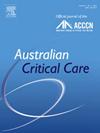Medical emergency team stand-down decision-making: Characteristics, documented decisions, and outcomes documented between single and repeat medical emergency team patients—A retrospective review
IF 2.7
3区 医学
Q2 CRITICAL CARE MEDICINE
引用次数: 0
Abstract
Introduction
Decisions to end a medical emergency team (MET) call have been infrequently studied. Premature ending of MET calls may compromise patient outcomes. The aim of the study was to describe clinicians' documentation practices upon ending MET calls and to compare patients with single and repeat MET call activation on the initial call.
Methods
A retrospective review was conducted at a metropolitan hospital in Melbourne, Victoria, from Oct 1st, 2018, to September 30th, 2019. From a total of 8648 initial MET calls, 500 were included in the sample, 250 single and 250 repeated (≥2) MET calls. Data from patients’ index MET call were analysed using univariate analyses and descriptive statistics. Variables included documentation of the MET call stand-down decision and associated decision-making elements, demographic and admission characteristics, and patient outcomes. We compared documentation of MET call stand-down decision-making with expert consensus on essential MET call stand-down decision-making elements.
Results
Key differences in the documentation of the essential MET call stand-down decision-making elements were that repeat MET patients had a higher proportion of care outcomes (post-MET call) documented (72%) than single MET patients (48.8%). Treatment decisions were documented over 75% of the time and an escalation plan was documented less than 50% of the time for both MET call patient groups. Repeat MET call patients were twice as likely to die in hospital (15.2% versus 7.6%, p = 0.01), had double the hospital length of stay (21 versus 10 days, p = 0.031), and were three times more likely to be discharged to rehabilitation services rather than home (28% versus 9.6%, p = 0.001).
Conclusion
There were differences at the index MET call in documentation and outcomes between patients who required a single MET call and those who required repeat MET calls. Prospective observational research is recommended to better understand the MET call stand-down decision-making process at the patient bedside, environmental influences, and the impact on further patient deterioration.
医疗急救小组停止决策:单个和重复医疗急救小组患者之间的特征、记录的决策和记录的结果-回顾性回顾
结束医疗急救小组(MET)呼叫的决定很少被研究。过早结束MET呼叫可能会损害患者的预后。该研究的目的是描述临床医生在结束MET呼叫时的记录实践,并比较初次呼叫时单一和重复MET呼叫激活的患者。方法回顾性分析2018年10月1日至2019年9月30日在维多利亚州墨尔本一家大都会医院进行的临床研究。从8648个初始MET呼叫中,500个被纳入样本,250个是单一的MET呼叫,250个是重复的(≥2)MET呼叫。使用单变量分析和描述性统计分析患者索引MET呼叫的数据。变量包括MET呼叫停止决定和相关决策因素的文件,人口统计学和入院特征以及患者结果。我们比较了MET呼叫停机决策的文件与专家共识的基本MET呼叫停机决策要素。结果基本MET呼叫停止决策要素记录的关键差异是,重复MET患者记录的护理结果(MET呼叫后)比例(72%)高于单一MET患者(48.8%)。两个MET呼叫患者组的治疗决定记录率超过75%,升级计划记录率不到50%。重复MET呼叫的患者在医院死亡的可能性是前者的两倍(15.2%对7.6%,p = 0.01),住院时间是后者的两倍(21天对10天,p = 0.031),出院到康复服务中心而不是回家的可能性是后者的三倍(28%对9.6%,p = 0.001)。结论:单次MET呼叫与多次MET呼叫的患者在MET呼叫的记录和结果上存在差异。建议进行前瞻性观察研究,以更好地了解患者床边的MET呼叫停药决策过程、环境影响以及对患者进一步恶化的影响。
本文章由计算机程序翻译,如有差异,请以英文原文为准。
求助全文
约1分钟内获得全文
求助全文
来源期刊

Australian Critical Care
NURSING-NURSING
CiteScore
4.90
自引率
9.10%
发文量
148
审稿时长
>12 weeks
期刊介绍:
Australian Critical Care is the official journal of the Australian College of Critical Care Nurses (ACCCN). It is a bi-monthly peer-reviewed journal, providing clinically relevant research, reviews and articles of interest to the critical care community. Australian Critical Care publishes peer-reviewed scholarly papers that report research findings, research-based reviews, discussion papers and commentaries which are of interest to an international readership of critical care practitioners, educators, administrators and researchers. Interprofessional articles are welcomed.
 求助内容:
求助内容: 应助结果提醒方式:
应助结果提醒方式:


